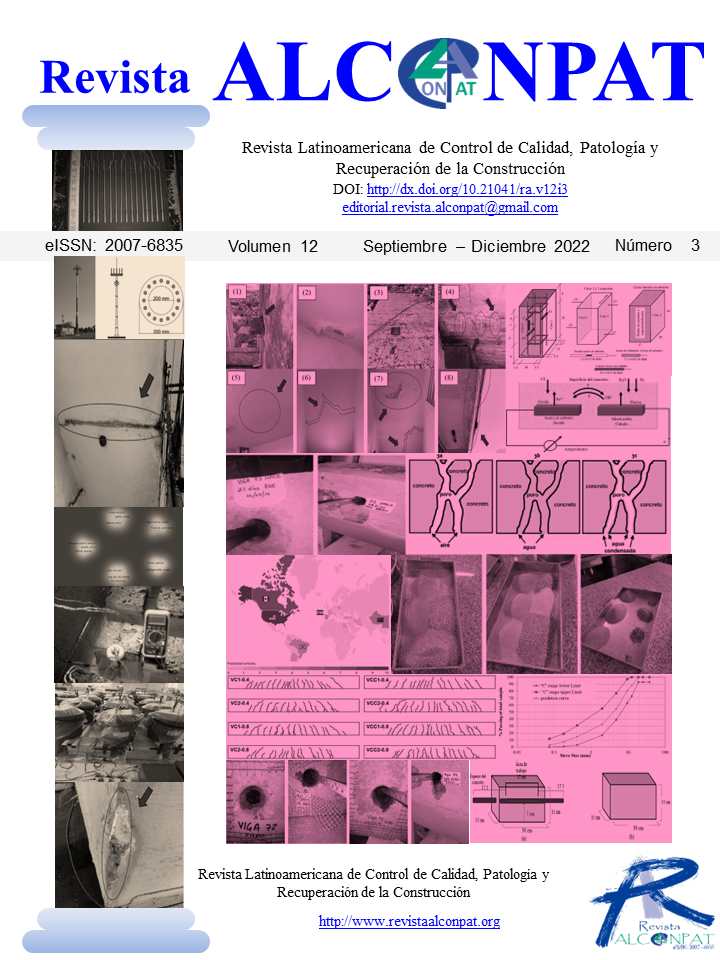Flexural behavior of reinforced concrete beams with electrochemical parameters associated with high level of corrosion
DOI:
https://doi.org/10.21041/ra.v12i3.630Keywords:
reinforced concrete beams, corrosion, sustained loads, structural behavior, electrochemical behaviorAbstract
In this work the change in the flexural behavior of reinforced concrete beams was evaluated. Beams without corrosion and beams with electrochemical parameters associated with high level of corrosion were considered. The electrochemical parameters considered were the corrosion rate, the electrical resistivity, and the concentration of chlorides. Beams were subjected to vertical incremental loads until failure. Cracking patterns, yielding loads, maximum loads, yielding stiffnesses, and displacement ductilities of beams are presented. Based on the analysis of these structural parameters it is concluded that the flexural behavior of beams with and without corrosion was similar.
Downloads
References
Andrade F., y González J.A. (1978). Quantitative measurements of corrosion rate of reinforcing steels embedded in concrete using polarization resistance measurements. Materials and Corrosion. 29(8): 515-519.
Andrade, C. (1993), Calculation of chloride diffusion-coefficients in concrete from ionic migration measurements. Cement and Concrete Research, 23 (3): 724-742. https://doi.org/10.1016/0008-8846(93)90023-3.
Castro P. (1998). “Corrosión en Estructuras de Concreto: teoría, inspección, diagnóstico, vida útil y reparaciones”. 1ª Edición. Instituto Mexicano del Cemento y del Concreto A.C., México, DF.
Castel A., François R., Arliguie G. (2000). Mechanical behaviour of corroded reinforced concrete beams—Part 1: Experimental study of corroded beams. Materials and Structures, 33: 539-544, https://doi.org/10.1007/BF02480533
Ceballos, M. (2016). “El concreto, material fundamental para la infraestructura.” Centro de Innovación Tecnológica para la Construcción. pp. 24-25.
Elsener, B., Andrade, C. Gulikers, J., Polder, R y Raupach, M. (2003). Half-cell potential measurements—Potential mapping on reinforced concrete structures. Materials and Structures. 36: 461–471, https://doi.org/10.1007/BF02481526
Gu X., Zhang W., Shang D., Wang X. (2010). “Flexural Behavior of Corroded Reinforced Concrete Beams.” Earth and Space 2010: Engineering, Science, Construction, and Operations in Challenging Environments, ASCE, 2, 3545–3552. https://doi.org/10.1061/41096(366)339
Juárez, C. A., Guevara, B., Fajardo, G., & Castro-Borges, P. (2011). Ultimate and nominal shear strength in reinforced concrete beams deteriorated by corrosion. Engineering Structures, 33(8): 3189-3196. https://doi.org/10.1016/j.engstruct.2011.08.014
Maldonado López, L. (1996). “Corrosión del acero de refuerzo: revisión del estado del arte en México.” En F. d. Yucatán (Ed.), VII Seminario de Investigación, (pág. 18). Mérida, Yucatán, México.
Moreno-Herrera, J., Visairo-Méndez, R., Varela-Rivera, J., Balancan-Zapata, M., y Castro-Borges, P. (2022). Enviado a: Corrosion, The Journal of Science and Engineering.
NMX-C-501-ONNCCE-2015. (2015). “Industria de la Construcción - Durabilidad de Estructuras de Concreto Reforzado - Medición de Velocidad de Corrosión en Campo - Especificaciones y Método de Ensayo.” Organismo Nacional de Normalización y Certificación de la Construcción y Edificación, S.C.
NMX-C-514-ONNCCE-2016. (2016). “Industria de la Construcción - Resistividad Eléctrica del Concreto Hidráulico - Especificaciones y métodos de ensayo.” Organismo Nacional de Normalización y Certificación de la Construcción y Edificación, S.C.
NMX-C-523-ONNCCE-2016. (2016). “Industria de la construcción – Durabilidad de estructuras de concreto reforzado - Concentración de cloruros solubles en agua y ácido – determinación en concreto hidráulico - Método de extracción y método de determinación por ión selectivo.” Organismo Nacional de Normalización y Certificación de la Construcción y Edificación, S.C.
NTCC-2017 (2017). “Normas Técnicas Complementarias para Diseño y Construcción de Estructuras de Concreto.” Órgano del Gobierno del Distrito Federal, Jefatura de Gobierno. México, D.F.: Administración Pública del Distrito Federal.
Ou Y., Susanto Y., Roh H. (2016). Tensile behavior of naturally and artificially corroded steel bars. Construction and Building Materials, 103: 93–104, https://doi.org/10.1016/j.conbuildmat.2015.10.075
Rodriguez-Rodriguez, A. (2014). Las pérdidas económicas causadas por el fenómeno de la corrosión atmosférica del acero de refuerzo embebido en el hormigón armado. CENIC: Ciencias Químicas, 45: 52-59.
Shaikh, F.U.A. (2018). Effect of Cracking on Corrosion of Steel in Concrete. International Journal of Concrete Structures and Materials, 12(3), https://doi.org/10.1186/s40069-018-0234-y
Tachibana Y., Maeda K., Kajikawa Y., Kawuamura M. (1990). Mechanical behavior of RC beams damaged by corrosion of reinforcement. Corrosion of Reinforcement in Concrete Construction, 178-187.
Torres Acosta, A., Navarro Gutiérrez, S., & Terán, C. (2007). Residual flexure capacity of corroded reinforced concrete beams. Engineering Structures, 1145-1152. https://doi.org/10.1016/j.engstruct.2006.07.018.
Vázquez Castillo, C. D. (1998). “Diagnóstico de la corrosión del puente de Celestún.” Tesis. Mérida, Yucatán, México: Facultad de Ingeniería, Universidad Autónoma de Yucatán.
Vidal T., Castel A., François R. (2007). Corrosion process and structural performance of a 17 year old reinforced concrete beam stored in chloride environment. Cement and Concrete Research, 37(11): 1551-1561, https://doi.org/10.1016/j.cemconres.2007.08.004
Xianming, S., Ning, X., Keith, F., Jing, G. (2012) Durability of steel reinforced concrete in chloride environments: An overview. Construction and Building Materials, 37: 36-40, https://doi.org/10.1016/j.conbuildmat.2011.12.038
Ye, H., Fu, C., Jin, N., Jin, X. (2018). Performance of reinforced concrete beams corroded under sustained service loads: A comparative study of two accelerated corrosion techniques. Construction and Building Materials, 162: 286–297, https://doi.org/10.1016/j.conbuildmat.2017.10.108
Yu, L., François, R., Hiep, V., L’Hostis, V., Gagné, R. (2015). Development of chloride-induced corrosion in pre-cracked RC beams under sustained loading: Effect of load-induced cracks, concrete cover, and exposure conditions. Cement and Concrete Research, 67: 246–258, https://doi.org/10.1016/j.cemconres.2014.10.007
Downloads
Published
How to Cite
Issue
Section
License
_______________________________
License in effect from September 2020
You are free to:
- Share — copy and redistribute the material in any medium or format for any purpose, even commercially.
- Adapt — remix, transform, and build upon the material for any purpose, even commercially.
- The licensor cannot revoke these freedoms as long as you follow the license terms.
Under the following terms:
- Attribution — You must give appropriate credit , provide a link to the license, and indicate if changes were made . You may do so in any reasonable manner, but not in any way that suggests the licensor endorses you or your use.
- No additional restrictions — You may not apply legal terms or technological measures that legally restrict others from doing anything the license permits.
Notices:
You do not have to comply with the license for elements of the material in the public domain or where your use is permitted by an applicable exception or limitation .
No warranties are given. The license may not give you all of the permissions necessary for your intended use. For example, other rights such as publicity, privacy, or moral rights may limit how you use the material.





















.png)














